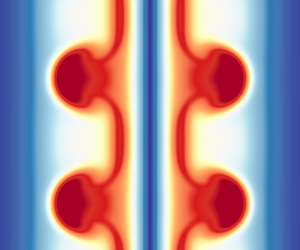No CrossRef data available.
Published online by Cambridge University Press: 20 February 2023

We carry out a weakly nonlinear analysis of the centrifugal instability for a columnar vortex in a rotating fluid, and compare the results to those of the semi-linear model derived empirically by Yim et al. (J. Fluid Mech., vol. 897, 2020, A34). The asymptotic analysis assumes that the Reynolds number is close to the instability threshold so that the perturbation is only marginally unstable. This leads to two coupled equations that govern the evolutions of the amplitude of the perturbation and of the mean flow under the effect of the Reynolds stresses due to the perturbation. These equations differ from the Stuart–Landau amplitude equation or coupled amplitude equations involving a mean field that have been derived previously. In particular, the amplitude does not saturate to a constant as in the supercritical Stuart–Landau equation, but decays afterwards reflecting the instability disappearance when the mean flow tends toward a neutrally stable profile in the direct numerical simulations (DNS). These equations resemble those of the semi-linear model except that the perturbation in the weakly nonlinear model keeps at leading order the structure of the eigenmode of the unperturbed base flow. The predictions of the weakly nonlinear equations are compared to those of the semi-linear model and to DNS for the Rossby number  $Ro=-4$ and various Reynolds numbers and wavenumbers. They are in good agreement with the DNS when the growth rate is sufficiently small. However, the agreement deteriorates and becomes only qualitative for parameters away from the marginal values, whereas the semi-linear model continues to be in better agreement with the DNS.
$Ro=-4$ and various Reynolds numbers and wavenumbers. They are in good agreement with the DNS when the growth rate is sufficiently small. However, the agreement deteriorates and becomes only qualitative for parameters away from the marginal values, whereas the semi-linear model continues to be in better agreement with the DNS.